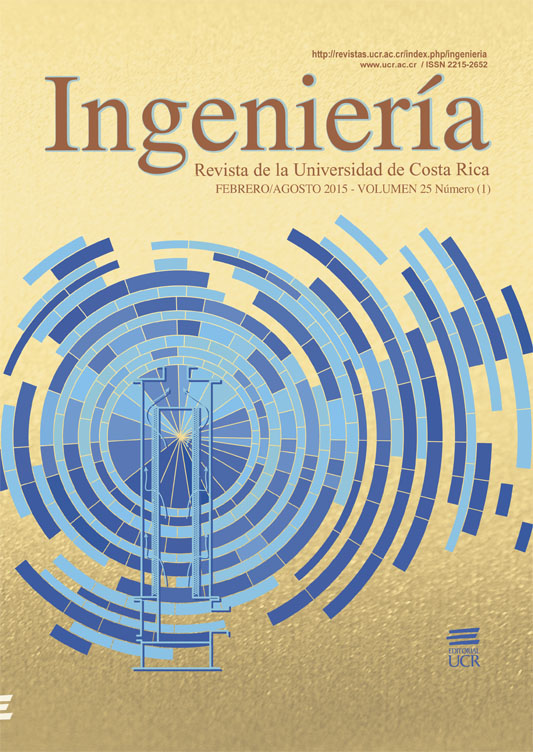Resumen
La exergía es un concepto que, desde su invención hace sesenta años, ha ido ganando popularidad y extendiéndose más allá de las aplicaciones de Ingeniería. Sin embargo, un estudio a profundidad del concepto revela la existencia de problemas e inconsistencias, tanto de tipo teórico como de aplicación. En este artículo se discuten seis problemas identificados: notación ambigua, estados de referencia ambiguos, aplicabilidad a procesos reales, redundancia con respecto a otras propiedades termodinámicas, inconstencia entre los conceptos de exergía y de trabajo perdido, y la aplicabilidad de los resultados del análisis exergético. Se proponen posibles caminos de solución para estos problemas, siendo el quinto el de más difícil solución porque requiere redefinir qué es la exergía.Citas
Abata, D. (2011). The Concept of Exergy. Notes for the courses ME211 Thermodynamics I and ME 312 Thermodynamics II. Recuperado de: abata.sdsmt.edu
Ayres, R. U.; Ayres, L. W.; Martinas, K. (1996). Eco-Termodynamics: Exergy and Life-Cycle Analysis. INSEAD Working Paper 96/04/EPS. Fontainebleau (France): INSEAD.
mora: Crítica del concepto de Exergía 81 Recuperado de: http://www.insead.edu/facultyresearch/research/doc.cfm?did=46686
Connelly, L.; Koshland, C. P. (2001). Exergy and industrial ecology—Part 1: An exergy-based definition of consumption and a thermodynamic interpretation of ecosystem evolution. Exergy, 1(3), 146-165. Recuperado de: http://www.sciencedirect.com/science/article/pii/S1164023501000218
Dincer, I.; Cengel, Y. A. (2001). Energy, Entropy and Exergy Concepts and Their Roles in Thermal Engineering. Entropy, 3, 116-149. Recuperado de: http://www.mdpi.com/1099-4300/3/3/116
Faria, S. H. B.; Zemp, R. J. (2005). Using exergy loss profiles and enthalpy-temperature profiles for the evaluation of thermodynamic efficiency in distillation columns. Thermal
Eng., 4(1), 76-82. Recuperado de: http://ojs.c3sl.ufpr.br/ojs/index.php/reterm/article/view/3553
Gibbs, J.W. (1873). A Method of Geometrical Representation of the Thermodynamic Properties of Substances by Means of Surfaces. Transactions of the Connecticut Academy of
Arts and Sciences, 2 Dec. 1873, p. 400.
Glasstone, S. (1946). Textbook of Physical Chemistry (2nd ed.). New York: Van Nostrand Co.
Green, D. W.; Perry, R. H. (2008). Perry´s Chemical Engineers´ Handbook (8th ed.). New York: McGraw Hill.
Kaiser, V.; Gourtia, J. P. (1985). The Ideal-Column Concept: Applying Exergy to Distillation. Chem. Eng. 92 (8), 45-53.
Linnhoff, B. (1979). Thermodynamic Analysis in the Design of Process Networks. (Ph. D. Dissertation). Leeds (UK): Univ. of Leeds, Dept. of Chem. Eng. Recuperado de: http://etheses.whiterose.ac.uk/2778/1/Linhoff_B_ChemicalEngineering_ PhD_1979.pdf
LowEx. (2002). Low Temperature Heating Systems: Increased Energy Efficiency and Improved Comfort. Brochure from the International Low Temperature Heating Systems
Programme, IEA ECBCS. Recuperado de: lowex.net
Martínez, I. (1992). Termodinámica básica y aplicada. Capítulo 3 “Exergía”, pp. 45-49. Madrid (España): Dossat.
Meggers, F.;Ritter, V.; Goffin, P.; Baetschmann, M.; Leibundgut, H. (2012). Low exergy building systems implementation. Energy, 41(1), pp.48–55. Recuperado de: http://www.sciencedirect.com/science/article/pii/S0360544211004798
Morosuk, T.; Tsatsaronis, G. (2009). Advanced Exergy Analysis for Chemically Reacting Systems – Application to a Simple Open Gas-Turbine System. Int. J. of Thermodynamics,
(3), 105-111. Recuperado de: http://www.ijoticat.com/index.php/IJoT/article/viewFile/245/227
Pisa, J; Agüero, C, Andina, R. (2010). Límites en el uso de balances de exergía en los sistemas de cogeneración. Revista CET, 32, 32-36. Recuperado de: http://www.herrera.unt.edu.
ar/revistacet/?page_id=310
Pons, M. (2009). On the Reference State when Ambient Temperature Fluctuates. Int J. of Thermodynamics, 12(3), 113-121. Recuperado de:http://www.ijoticat.com/index.php/
IJoT/article/viewFile/246/228
Rosen, M. A.; Dincer, I. (2004). Effect of varying dead-state properties on energy and exergy analyses of thermal systems. Int. J. of Thermal Sciences, 43(2), 121-133. Recuperado de: http://www.sciencedirect.com/science/article/pii/ S1290072903001418
Sciubba, E.; Wall, G. (2007). A Brief Commented History of Exergy From the Beginnings to 2004. Int. J. of Thermodynamics, 10(1), 1-26. Recuperado de: http://www.ehakem.com/index.php/IJoT/article/viewFile/184/170
Simpson, A. P.; Edwards, C. F. (2011). An exergybased framework for evaluating environmental impact. Energy, 36 (1), 1442-1459. Recuperado de:http://www.sciencedirect.com/science/article/pii/S0360544211000260
Smith, J. M.; Van Ness, H. C.; Abbott, M. M. (2001). An Introduction to Chemical Engineering Thermodynamics (6th ed.). New York: McGraw Hill.
Smith, J. M.; Van Ness, H. C.; Abbott, M. M. (2004). An Introduction to Chemical Engineering Thermodynamics (7th ed.). New York: McGraw Hill.
Stremke, S.; van del Dobbelsteen, A.; Koh, J. (2011). Exergy landscapes: exploration of second-law thinking towards sustainable landscape design. Int. J. Exergy, Vol. 8, No. 2, 148-174. Recuperado de: http://www.exergieplanning.nl/publicaties/2011%20-%20Exergy%20Landscapes%20Stremke%20Dobbelsteen%20 Koh.pdf
Shukuya, M. (2005). Towards Sustainable Arquitecture. Proceedings of the 2005 World Sustainable Building Conference, Tokio (Japan). Recuperado de: lowex.net
Szargut, J.; Morris, D. R.; Steward, F. R. (1988). Exergy Analysis of Thermal, Chemical and Metalurgical Processes. New York: Hemisphere Publishing Corp.
Tsatsaronis, G. (1999). Strengths and Limitations of Exergy Analysis. In: Bejan, A. & Mamut, E. Thermodynamic Optimization of Complex Energy Systems, pp. 93-100. Dordrecht: Kluwer Academic Publishers. Recuperado
fcfd5145a781a9468.pdf
Tsatsaronis, G. (2007). Comments on the Paper ‘A Brief Commented History of Exergy from the Beginnings to 2004’. Int. J. of Thermodynamics, 10(4), 187-192. Recuperado
de: http://www.ijoticat.com/index.php/IJoT/article/viewFile/202/188
Van Wylen, G. J.; Sonntag, R. E. (1965). Fundamentals of Classical Thermodynamics (1st ed.).New York: Wiley.
Van Wylen, G. J.; Sonntag, R. E. (1976). Fundamentals of Classical Thermodynamics (2nd ed.). New York: Wiley.
Wall, G. (1977). Exergy – A Useful Concept. (Doctoral thesis, Chalmers Institute of Technology) Göteborg, Sweden. Recuperado de: exergy.se
Wall, G. (1986). Exergy Flow in Industrial Processes. Recuperado de: exergy.se
Wall, G. (1991). On the Optimization of Refrigeration
Machinery. Int. J. of Refrigeration, 14, 336-340. Recuperado de: exergy.se
Wall, G. (1992). A Bibliography of Exergy. Recuperado de: exergy.se
Zhinhong, L.; Ben, H. (2000). Optimal Design of Heat of Heat Exchanger Network Synthesis based on Exergy-Economic
Object and Strategy of Decomposition and Coordination. Journal of Chem. Ind. And Eng. (China), 51(1), 96-101. Recuperado de: http://www.hgxb.com.cn/EN/abstract/
abstract8681.shtml
Zvolinsky, A. (2006). On exergy analysis and entropy production minimisation in industrial ecology. (Doctoral thesis). Trondheim: Norwegian University of Science and Technology. Recuperado de: http://ntnu.diva-portal.org/smash/record.jsf? pid=diva2:122541


